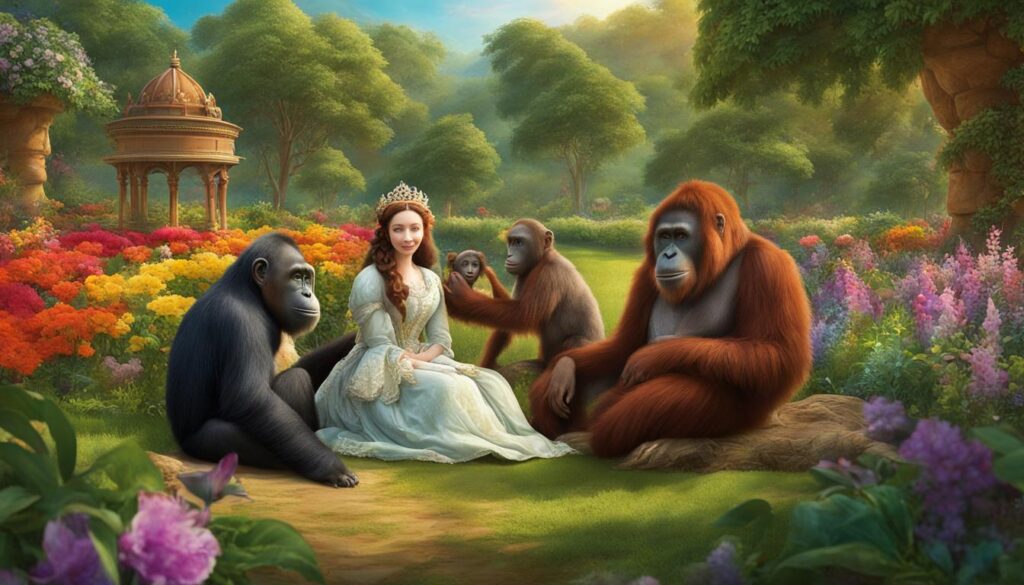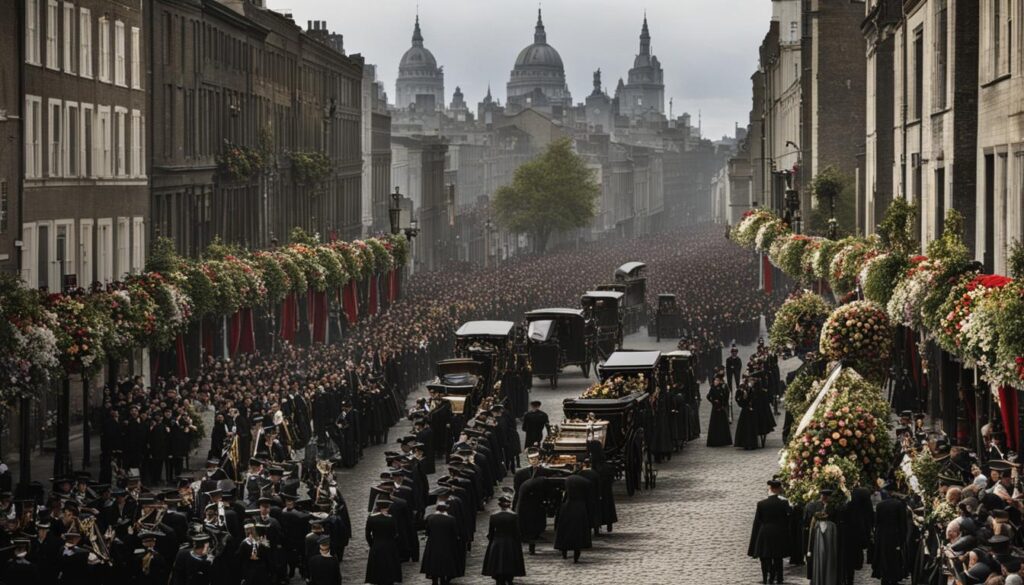Queen Victoria, the beloved monarch of the Victorian era, was not only known for her reign but also for her deep affection for dogs. As a royal dog lover, she cherished her pet dogs and they became an integral part of her life and legacy. Queen Victoria’s favorite dogs included Cairnach and Islay, two Skye terriers who captured her heart with their gentle nature and delightful antics. These royal pet dogs brought joy and companionship to Queen Victoria during her reign.
Queen Victoria’s love for dogs was evident in her close bond with Islay, who even became a muse for the renowned painter Edwin Landseer. Islay’s charming personality and friendly nature endeared him to both the Queen and her prime minister Lord Melbourne, who also formed a close connection with the royal pet. In addition to her favorite Skye terriers, Queen Victoria had a fondness for other dog breeds, including St Bernard puppies and various working canines like war dogs and railway dogs, which served different purposes during that time.
Key Takeaways:
- Queen Victoria had a deep affection for dogs and considered them her royal companions.
- Her favorite dogs included Cairnach and Islay, Skye terriers known for their gentle nature.
- Islay, the royal muse, captured the attention of the renowned painter Edwin Landseer.
- Queen Victoria also had an affinity for other dog breeds, such as St Bernard puppies and working canines like war dogs and railway dogs.
- Her love for dogs added depth to her reign and left a lasting legacy as a royal dog lover.
Dogs: Queen Victoria’s Best Friends
Dogs held a special place in Queen Victoria’s heart. Throughout her lifetime, she formed close bonds with numerous canine companions, showcasing her deep affection for these loyal animals. One of her most cherished dogs was her Skye terrier, Islay, who became a beloved muse for the renowned painter Edwin Landseer. But Islay wasn’t the only dog to capture Victoria’s heart.
Queen Victoria had a fondness for various breeds, including St Bernard puppies known for their gentle nature and working canines that played vital roles in different areas. She even had a particular interest in war dogs, recognizing their bravery and their invaluable support in times of conflict. Additionally, Victoria was intrigued by the intelligence and usefulness of railway dogs, who served important functions in the transportation sector.
Whether it was her beloved Islay or the diverse canines she encountered and admired, Queen Victoria’s love for dogs was apparent throughout her life. These loyal companions brought her joy and comfort, and she treasured their presence as part of her royal entourage.
Cats and Other Feline Companions
During the Victorian era, Queen Victoria’s love for animals extended beyond her beloved dogs. Although dogs held a special place in her heart, Victoria also showed fondness for cats. One particular incident that showcased her kindness was when she accepted a kitten as a gift from a poor family. The sender of the kitten even expressed their gratitude to the Queen in a heartfelt letter. This act of charity demonstrated Victoria’s compassion and empathy towards all creatures, not just her canine companions.
Additionally, there is a whimsical tale of Victoria’s encounter with a singing mouse. This little performer was brought to Buckingham Palace to entertain the Queen and the royal family. Although it remains unknown whether the mouse regained its voice during the performance, this amusing episode reveals Victoria’s willingness to be entertained by all sorts of creatures, no matter how unconventional.
Feline Companions and Victoria’s Legacy
While it’s evident that Queen Victoria’s dogs held a special place in her heart, her interaction with cats and other feline companions showcases her love for animals as a whole. From her act of charity in accepting the gifted kitten to her amusing encounter with a singing mouse, Victoria’s affinity for these creatures adds depth to her legacy as not only a monarch but also an animal lover.
Feathered Friends: Parrots and More
Queen Victoria’s love for animals extended beyond her dogs to include a diverse range of animal companions. Among these were her cherished parrots, which added a vibrant and colorful dimension to her royal household. One of the notable parrots in Victoria’s collection was Pedro, a blue and green Brazilian parrot known for his striking plumage.
But Victoria’s feathered friends weren’t limited to Pedro. She also had a highly-colored lory and an African grey parrot. The African grey parrot was particularly remarkable for its intelligence, boasting an impressive vocabulary of over 800 words. These intelligent birds brought joy and entertainment to Victoria’s life, engaging her with their playful antics and vocal abilities.
With her parrots, Queen Victoria embraced the beauty and diversity of the avian world. These intelligent and charismatic creatures were part of the royal legacy she left behind, showcasing her appreciation for the natural world and the intriguing qualities of each animal she welcomed into her home.
Wildlife Exploration: Zoos and More
I have always been fascinated by animals and their unique behaviors. During Queen Victoria’s reign, the opening of British Victorian zoos provided her and her family with the opportunity to explore and engage with a wide variety of wildlife. One of Victoria’s favorite zoos was Regent’s Park, located in the heart of London. This expansive zoo allowed visitors to observe animals from all corners of the world, creating a truly immersive experience.
Another notable zoo that Victoria frequented was the Surrey Zoological Gardens. Located just outside of London, this zoo boasted an impressive collection of animals, including exotic species like lions, tigers, and even elephants. Victoria would often spend hours wandering through the gardens, captivated by the diverse array of creatures before her.
The Fascination with Jenny the Orangutan
Among the many animals Victoria encountered during her visits to the zoos, one in particular caught her attention – an orangutan named Jenny. Jenny was a star attraction at the Surrey Zoological Gardens, known for her ability to mimic human behavior and wear clothes. Her antics amused Victoria and the royal family, adding a touch of whimsy to their zoo outings.
It was during one of Victoria’s visits to the Surrey Zoological Gardens that she witnessed Jenny’s extraordinary talent. Jenny donned a bonnet and gown specially made for her by a dressmaker and delighted the crowd with her human-like movements and gestures. This encounter with Jenny helped solidify Charles Darwin’s theories of evolution, as it highlighted the striking similarities between humans and our primate relatives.

Queen Victoria’s visits to the zoos not only allowed her to enrich her understanding of the natural world but also provided an escape from the pressures of her royal responsibilities. It was in these moments, surrounded by the wonders of the animal kingdom, that Victoria could truly connect with the beauty and diversity of nature.
The End of an Era: Queen Victoria’s Death
Queen Victoria’s reign came to a somber end with her passing at the age of 81. The news of her death sent shockwaves throughout the nation and marked the end of an era. Victoria’s health had been in decline for some time, with impaired eyesight and rheumatism plaguing her in her final years. Tragically, she succumbed to a cerebral hemorrhage, forever leaving a void in the hearts of her subjects and admirers.
The loss of Queen Victoria was felt deeply by the British people, who mourned the passing of their beloved monarch. As the longest-reigning monarch in British history at the time, Victoria had become a symbol of stability and continuity. Her death ushered in a period of mourning and reflection on her remarkable reign.
Victoria’s death also marked a significant shift in the monarchy’s dynamics. Her eldest son, Edward VII, ascended to the throne, bringing with him a new era and a different style of leadership. But the memory of Queen Victoria and her legacy as a compassionate and dedicated ruler would endure for generations to come.
The Final Farewell: Queen Victoria’s Funeral
The passing of Queen Victoria was followed by a grand funeral ceremony, meticulously planned by the monarch herself. Her funeral procession was a solemn and dignified affair, befitting the stature of the late queen. A gun carriage carried her coffin, accompanied by navy and army officers, as well as mourners paying their respects.
Victoria’s funeral marked a momentous event in British history, as it set many precedents for state funerals to come. She requested a white funeral, a departure from the customary black, as a symbol of purity. The military service that took place was a testament to her reign’s close ties with the armed forces.
Fittingly, Queen Victoria was laid to rest in the Frogmore Mausoleum alongside her beloved late husband, Prince Albert. Their final resting place became a site of pilgrimage for those wanting to pay homage to the iconic couple who had left an indelible mark on British history.
Farewell to a Monarch: Queen Victoria’s Funeral
As the nation mourned the loss of Queen Victoria, her meticulously planned funeral took place, marking a significant moment in British history. The grand procession, held with utmost solemnity, honored the beloved monarch’s legacy.
The funeral procession was a sight to behold, with a gun carriage carrying Queen Victoria’s adorned coffin, accompanied by navy and army officers in full regalia. Mourners from all walks of life lined the streets to pay their respects to the monarch who had reigned for over six decades.
Queen Victoria had requested a white funeral, a symbol of purity and dignity, and her wishes were meticulously followed. The military service added a sense of grandeur to the occasion, highlighting the Queen’s stature as the head of the armed forces.

A Lasting Tribute
Queen Victoria’s final resting place is the Frogmore Mausoleum, where she was interred alongside her beloved late husband Prince Albert. This serene and picturesque setting serves as a lasting tribute to the Queen and her legacy.
Her funeral and the subsequent interment marked the end of an era, as Victoria’s reign was the longest in British history at that time. The nation bid farewell to a monarch who had witnessed significant changes and left an indelible mark on the monarchy.
Queen Victoria’s funeral encapsulated the reverence and respect the nation had for their beloved queen. It was a moment that showcased the enduring impact of her reign and the profound loss felt by the British people.
Succession: Edward VII Takes the Throne
After the passing of Queen Victoria, the responsibility of ruling the British monarchy fell upon her eldest son, Edward VII. Known affectionately as Bertie, Edward took the throne and embarked on a reign that would witness significant changes in both the monarchy and society as a whole. His ascension marked a new era in British history, known as the Edwardian period, characterized by social transformation and political reforms.
As the new king, Edward VII embraced a more social and fashionable lifestyle, distinguishing himself from his mother’s more reserved approach. He sought to strengthen England’s relationships with Europe, playing a crucial role in international diplomacy. Edward also implemented military and naval reforms, modernizing and fortifying the country’s defense.
Edward’s reign coincided with a period of profound social changes. The Edwardian era saw the rise of socialism, with growing discontent among the working class and calls for greater equality. Additionally, the women’s suffrage movement gained momentum, advocating for women’s right to vote. These social shifts challenged traditional norms and laid the foundation for the societal changes that would shape the 20th century.
A Lasting Legacy: Queen Victoria’s Impact
Queen Victoria’s reign had a profound and lasting impact on the history of Britain. As a constitutional monarch, she played a pivotal role in defining the position of the monarchy as separate from political parties. This separation allowed the monarch to serve as a unifying and ceremonial figurehead for the nation, representing the unity and continuity of the British people.
Queen Victoria’s legacy as a constitutional monarch continued to shape the role of the monarchy long after her reign. Her commitment to her ceremonial duties set a precedent for future monarchs to serve as symbols of national pride and tradition, while allowing elected officials to govern the country. This balance between tradition and democracy remains a defining characteristic of the British monarchy.
During the Edwardian period, which followed Queen Victoria’s reign, her influence continued to be felt. The Edwardian era was marked by a focus on social reforms and a growing awareness of the welfare of the British people. Queen Victoria’s impact as a compassionate and caring ruler laid the groundwork for these reforms, leading to the development of a more inclusive and egalitarian society.
The Legacy of Queen Victoria’s Reign
Queen Victoria’s legacy as a constitutional monarch and her role in shaping the ceremonial nature of the British monarchy cannot be overstated. Her reign set the stage for future monarchs to serve as symbols of unity and tradition, while allowing the democratic government to govern the country. The impact of her reign was felt not only during her time on the throne but also in the years that followed, as her values and beliefs guided the development of a more inclusive and compassionate society.
Conclusion
Throughout Queen Victoria’s reign, her deep love for her dogs and other animals left a royal legacy that continues to be celebrated today. As a passionate animal lover, she formed a unique bond with her pets, showcasing her compassion and adding a special depth to her role as monarch. From her favorite dogs, Cairnach and Islay, to her collection of parrots, Victoria’s affection for animals was evident.
Queen Victoria’s devotion to her dogs and other animal companions not only brought her personal joy but also exemplified her caring nature. Her furry friends became an integral part of her life, and their stories continue to captivate and inspire us. Through her love for animals, Queen Victoria’s legacy as both a monarch and an animal lover is firmly etched in history.
Queen Victoria’s royal legacy extends far beyond her love for animals. She played a significant role in shaping the constitutional monarchy, defining its position as separate from political parties. Her reign also marked the beginning of the monarchy’s more ceremonial role, which continues to this day. Through her influence, Victoria’s legacy transitioned into the Edwardian period, impacting the development of the British welfare state.
Queen Victoria’s deep affection for her dogs, parrots, and other animals left an indelible mark on history. Her legacy as a monarch and an animal lover is a testament to her compassion and devotion. As we reflect on the charming tales of Queen Victoria’s dogs and animal companions, we are reminded of her lasting impact and the enduring bond between humans and animals.
FAQ
Did Queen Victoria have a favorite dog?
Yes, Queen Victoria had a deep affection for her dogs, and some of her most beloved pets were Cairnach and Islay, Skye terriers.
What was Islay, Queen Victoria’s Skye terrier, known for?
Islay was known for his gentle and friendly nature, as well as his delightful begging.
Did Queen Victoria have any other types of dogs?
Yes, Queen Victoria had an affinity for other types of dogs, such as St Bernard puppies and various working canines.
Did Queen Victoria like cats?
Queen Victoria showed some fondness for cats, and she even accepted a kitten as a gift from a poor family.
Did Queen Victoria have any pet parrots?
Yes, Queen Victoria had a collection of parrots, including a blue and green Brazilian parrot named Pedro and an African grey parrot.
Did Queen Victoria visit zoos?
Yes, Queen Victoria enjoyed frequent trips to zoos, including Regent’s Park Zoo and the Surrey Zoological Gardens.
What was Queen Victoria’s cause of death?
Queen Victoria passed away from a cerebral hemorrhage.
Where was Queen Victoria laid to rest?
Queen Victoria was laid to rest in Frogmore Mausoleum, alongside her late husband Prince Albert.
Who succeeded Queen Victoria on the throne?
Queen Victoria’s eldest son Edward VII, also known as Bertie, succeeded her on the throne.
What was Queen Victoria’s impact on British history?
Queen Victoria played a significant role in defining the constitutional monarch’s position and her reign marked the beginning of the modern monarchy’s ceremonial role.



